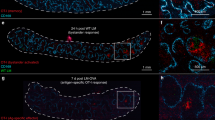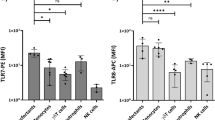Abstract
AN important process in the immune response is the migration of different populations of lymphocytes at the proper time to sites of antigenic challenge. Although several chemoattractants are known for broad classes of lymphocytes, such as T and B cells, the process by which lymphocytes of specific subsets, such as helper, cytotoxic or memory T cells, migrate to the appropriate sites remains obscure. Interleukin-8 is a chemoattractant for T cells and neutrophils and is a member of a superfamily of soluble molecules related by a conserved motif containing four cysteine residues. IL-8 and related molecules, including platelet factor 4, constitute the C-X-C class of the superfamily and a group of cytokines produced by haematopoietic cells3,4 constitute the RANTES/sis or C-C class4,5. The roles of most of these molecules are not well known, although murine MIP-lα of the C-C branch is a specific inhibitor of haematopoietic stem cell proliferation6 and some members of the C-X-C branch are neutrophil-targeted inflammatory agents7–10. Here we report that the RANTES protein3 of the C-C class causes the selective migration of human blood monocytes and of T lymphocytes expressing the cell surface antigens CD4 and UCHL1. CD4+/UCHL1+T cells are thought to be prestimulated or primed helper T cells involved in memory T cell function11–14. The preferential attraction of T-cell subsets by specific cytokines could in part explain how lymphocytes are targeted, and may provide insight into the workings of T cell memory.
Similar content being viewed by others
References
Larsen, C. G., Anderson, A. N., Appella, E., Oppenheim, J. J. & Matsushima, K. Science 243, 1461–1466 (1989).
Bacon, K.B., Westwick, J. & Camp, R. D. R. Biochem. biophys. Res. Commun. 165, 349–354 (1989).
Schall, T. J. et al. J. Immunol. 141, 1018–1025 (1988).
Brown, K. D., Zurawski, S. M., Mosmann, T. R. & Zurawski, G. J. Immunol. 142, 679–687 (1989).
Zipfel, P. F., Balke, J., Irving, S. G., Kelly, K. & Siebenlist, U. J. Immunol. 142, 1582–1590 (1989).
Graham, G. J. et al. Nature 344, 442–444 (1990).
Matsushima, K. et al. J. exp. Med. 167, 1883–1892 (1988).
Yoshimura, T. et al. Proc. natn. Acad. Sci. U.S.A. 84, 9233–9237 (1987).
Walz, A., DeWald, B., von Tscharner, V. & Baggiolini, M. J. exp. Med. 170, 1745–1750 (1989).
Schröder, J.-M., Sticherling, M., Henneicke, H. H., Preissner, W. C. & Christophers, E. J. Immunol. 144, 2223–2232 (1990).
Akbar, A. N., Terry, L., Timms, A., Beverley, P. C. L. & Janossy, G. J. Immun. 140, 2171–2178 (1988).
Merkenschlager, M., Terry, L., Edwards, R. & Beverley, P. C. L. Eur. J. Immun. 18, 1653–1661 (1988).
Sanders, M. E. et al. J. Immun. 140, 1401–1407 (1988).
Cerottini, J.-C. & MacDonald, H. R. A. Rev. Immun. 7, 77–89 (1989).
Graham, F. L., Smiley, J., Russel, W. L., Nairn, R. J. gen. Virol. 36, 59–77 (1977).
Gorman, C. in DNA Cloning Vol. II (eds Glover, D.) 143–190 (IRL, Oxford, 1985).
Bacon, K. B., Camp, R. D. R., Cunningham, F. M. & Woollard, P. M. Br. J. Pharmac. 95, 966–974 (1988).
Cordell, J. L. et al. J. Histochem. Cytochem. 132, 219–229 (1984).
Sanders, M. E., Makgoba, M. W. & Shaw, S. Immun. Today 9, 195–198 (1988).
Sanders, M. E., Makgoba, M. W., June, C. H., Yong, H. A. & Shaw, S. Eur. J. Immun. 19, 803–808 (1989).
Budd, R. C., Cerottini, J.-C. & MacDonald, H. R. J. Immun. 138, 3583–3586 (1987).
MacKay, C. R., Marston, W. L. & Dudler, L. J. exp. Med. 171, 801–817 (1990).
Schägger, H. & Von Jagow, G. Analyt. Biochem. 166, 368–379 (1987).
Unemori, E. & Werb, Z. J. biol. Chem. 263, 16252–16259 (1988).
Author information
Authors and Affiliations
Rights and permissions
About this article
Cite this article
Schall, T., Bacon, K., Toy, K. et al. Selective attraction of monocytes and T lymphocytes of the memory phenotype by cytokine RANTES. Nature 347, 669–671 (1990). https://doi.org/10.1038/347669a0
Received:
Accepted:
Issue Date:
DOI: https://doi.org/10.1038/347669a0
- Springer Nature Limited
This article is cited by
-
A pancreatic cancer organoid-in-matrix platform shows distinct sensitivities to T cell killing
Scientific Reports (2024)
-
The presence of cerebellar B cell aggregates is associated with a specific chemokine profile in the cerebrospinal fluid in a mouse model of multiple sclerosis
Journal of Neuroinflammation (2023)
-
Methylmercury directly modifies the 105th cysteine residue in oncostatin M to promote binding to tumor necrosis factor receptor 3 and inhibit cell growth
Archives of Toxicology (2023)
-
Peripheral T Cell Populations are Differentially Affected in Familial Mediterranean Fever, Chronic Granulomatous Disease, and Gout
Journal of Clinical Immunology (2023)
-
Expression and purification of recombinant human CCL5 and its biological characterization
The Protein Journal (2022)





